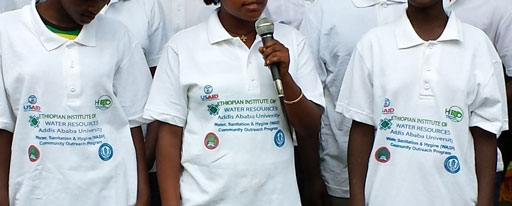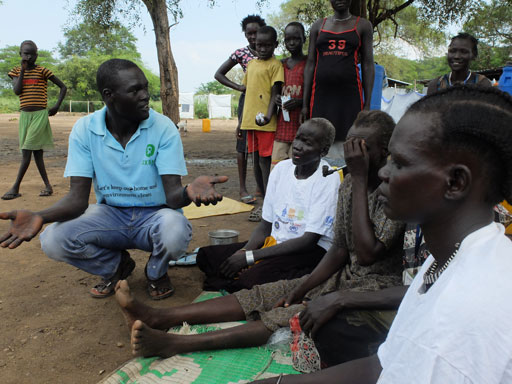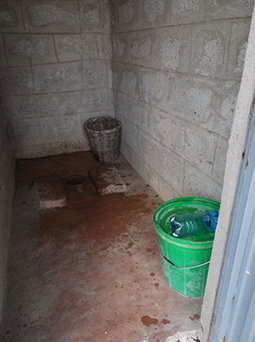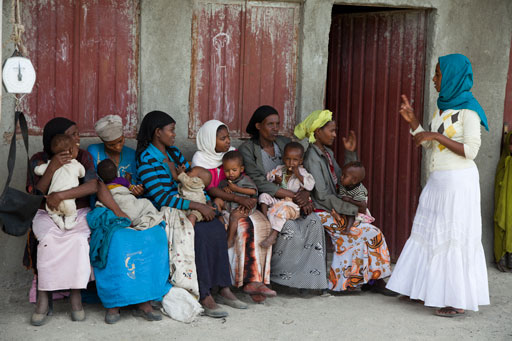Use 'Print preview' to check the number of pages and printer settings.
Print functionality varies between browsers.
Printable page generated Friday, 26 April 2024, 3:57 AM
Study Session 12 Advocacy and Networks
Introduction
Advocacy is an important part of your work as an urban WASH worker. This session will provide you with an overview of advocacy – its goals, objectives and practices, as well as its advantages and challenges, all of which should help you use advocacy to improve the status of WASH provision for the people in your community.
Learning Outcomes for Study Session 12
When you have studied this session, you should be able to:
12.1 Define and use correctly all of the key words printed in bold. (SAQs 12.1 and 12.2)
12.2 Identify the goals and objectives of advocacy. (SAQ 12.2)
12.3 Explain the role of networks in urban WASH advocacy. (SAQ 12.3)
12.4 Describe the advantages and challenges of working with networks for advocacy in an urban WASH context. (SAQs 12.3 and 12.4)
12.1 What is WASH advocacy?
Advocacy was introduced in Study Session 9 as one of the main approaches to influencing behaviour. It means making a case in support of a particular cause or activity and trying to convince other people, usually decision makers, that it is a good idea. Advocacy is a process to influence decisions within political, economic and social systems and institutions. In an urban WASH context, advocacy may include many activities that you and your organisation undertake including engaging opinion leaders, addressing community meetings, media campaigns and public speaking.
In general, advocacy approaches are either directed towards policies or towards programmes. Policy advocacy involves attempts to explain to senior politicians and administrators the impact of an issue at the national level and the need for changes to laws and policies (WHO, 2008). In a WASH context, an example is a media campaign to advocate a decrease in the tax imposed on soap to help improve use of soap. Programme advocacy takes place at a more local level. It involves attempts to explain to local leaders the need for action at local community level. In an urban WASH context this might include the mobilising of community leaders to promote the practice of handwashing or mobilising religious leaders to interpret and explain faith-based texts which refer to the importance of personal hygiene.
Advocacy for improving urban WASH services involves organising public opinion and participation to make changes in policy and practice as well as influencing policy makers and implementers to consider community interests. It can involve a range of strategies and activities that are intended to draw attention to an issue. Various materials and media can be used to communicate WASH information, not only posters and pamphlets but other options such as spoken messages or T-shirts, as shown in Figure 12.1.

Advocacy should be strategic and use well-designed and organised activities to influence policy or decision makers about the important issues that you think will affect the water supply, sanitation and hygiene of your community. For instance urban WASH policy, legislation and regulations may be in place but might not be applied. As a WASH practitioner you could identify these gaps and advocate the use of existing structures and mechanisms to try to close them.
12.2 Goals and objectives of WASH advocacy
The goals and objectives of WASH advocacy are to facilitate change and the development of policies to tackle unmet water supply, sanitation and hygiene needs or deal with emerging WASH service requirements in your community.
An advocacy goal is the desired result of any advocacy activity. It generally relates to a long-term result, which may take several years of advocacy work to achieve.
An advocacy goal:
- is a broad statement of what you are trying to do
- refers to the benefit that will be felt by those affected by an issue
- is long term and gives direction – it helps you know where you are going. It needs an accompanying route map or strategy to show you how to get there
- links to the mission and vision of your organisation or employer.
Without a goal, you may lose sight of what you are trying to do. Moreover it is vital to develop a goal that applies to the specific situation that needs to change.
Examples of urban WASH advocacy goals could include:
- significant improvement in coverage of clean water supply
- significant improvements in access to and use of household and community latrines
- reduction of child sickness in the community.
An advocacy objective is more specific than a goal. Objectives are the intended desired impacts of an advocacy activity such as the specific change that you want to see in improving urban WASH services. It often refers to the desired changes in policy and practice that will be necessary to help you and your community meet your goal.
When formulating a plan for an advocacy project, you should ensure your objectives meet the SMART criteria (Box 12.1). You also need to link these objectives to the resources available in order to be able to achieve them.
Box 12.1 SMART objectives
‘SMART’ is a way of reminding you that your objectives should be:
S: Specific – a specific objective that is clearly defined.
M: Measurable – your objective should be measurable.
A: Achievable – the objective should be attainable.
R: Realistic – which also means credible.
T: Time-bound – should be achieved within a certain time.
As a WASH practitioner you may need to influence community and political leaders in your locality. You may have multiple WASH issues in mind for improving the WASH situation, including policies, laws, regulations and programmes or funding from the public and private WASH sectors.
For example, despite their general understanding about their environmental and health impacts, some households still practise open defecation and irresponsible disposal of solid and liquid waste, which negatively influences their neighbourhoods. If the municipal and local governments are convinced of the negative influences, they may be prepared to introduce new bylaws, as well as implementing effective enforcement strategies that prohibit such practices. These could be your advocacy objectives. Such an advocacy initiative will contribute to the goal of improving environmental safety and health.
In order to develop an effective advocacy strategy that has a clear goal and objectives, you should understand the WASH situation and what needs to change. To prepare an advocacy strategy you will need knowledge of the local context because it is important to have and be able to provide evidence that supports your case. You will also need a good understanding of the key stakeholders and their roles, influence and importance (see Study Session 4).
12.3 Tools and methods for advocacy
How do you get support in the form of political will, funds and other resources from your leaders to facilitate WASH initiatives in your locality? There are a number of different methods that might be appropriate in different circumstances (Coulby, n.d.).
There will almost certainly be meetings involved in any advocacy campaign both with community members and with the people you are trying to influence. Organising meetings with decision makers so that you can brief them about a situation may be an effective way of raising awareness and presenting your case. Gathering all stakeholders together to discuss and coordinate activities will also be necessary.
Lobbying is a form of advocacy where a direct approach is made to legislators or other public officials about an issue. The term originates from the practice of waiting in the lobbies and corridors of government buildings in order to speak to politicians and lawmakers (Coulby, 2008). Nowadays, lobbying has a broader meaning and includes any direct attempt to influence policy, usually at national level.
Advocacy campaigns can make use of many of the communication tools we have discussed in previous study sessions including leaflets and posters that highlight the issue of concern. Messages through newspapers, radio and television programmes (also known as media advocacy) can be valuable if these facilities are available. Using entertainment such as drama and music is also a useful tool.
Being good at public speaking is an important skill for people involved in advocacy campaigns, especially those in leadership roles. It is important to be able to speak confidently and clearly if you are addressing large gatherings of people. Effective communication is also essential in smaller meetings with decision makers. They are likely to be busy people so you will need to get your message across to them quickly and clearly.
Now read Case Study 12.1 and answer the questions that follow.
Case Study 12.1, Part 1 Abebe and the dirty latrine
Abebe is an urban WASH worker in a small town in Amhara Region. Although there is a latrine in the market in his town, it is smelly and unpleasant and very few people use it. Moreover, although there is a bucket of water there, the bucket is dirty and the water is old and stagnant, so nobody uses it for handwashing. Many people avoid using these facilities altogether and a wooded area behind the market is often used for open defecation instead. Abebe has identified this as a major issue and realises that in the short term what is required is to clean up the existing facilities. In the medium term, it needs someone to clean the facilities, fill the bucket with fresh water and provide soap on a regular basis.
Identify two advocacy activities that Abebe could undertake to improve WASH service delivery.
There are many possible answers. You may have thought of two of the following:
- Raise awareness of the issue by arranging to meet local leaders.
- Arrange a meeting with the community to explore possible solutions.
- Engage opinion leaders.
- Initiate media campaigns.
- Speak at public meetings.
What would Abebe’s role be as an urban WASH practitioner in these advocacy activities?
Abebe could lead the advocacy effort or work with others as part of a team. His role would be to raise awareness of the issue to local leaders and to be a facilitator at the community meeting (Figure 12.2). He could try to identify individuals willing to clean the facility and refresh supplies of water and soap on a regular basis. He could also find out if money was available to pay them to do so and explore how much people might be prepared to pay to use the clean facility.

12.4 Networks for WASH advocacy
In common with many of the activities involved in trying to change people’s behaviour, advocacy is something that is very difficult to do on your own. Working in partnerships, alliances and coalitions with others will bring much better results. These collaborative organisations are all forms of network. A network is a collaborative body involving many participants from many organisations that (Coulby and Barcelo, n.d.):
- form around an issue or a general set of values
- have an explicit purpose
- communicate and interact towards achieving this purpose
- have a distinct, non-managerial, non-hierarchical form
- are facilitated by a designated person or body (chairperson, coordinator, secretariat, steering group, etc.).
Networks can connect people from a wide range of backgrounds with different expertise and experience. In the urban WASH sector, this may include practitioners as well as researchers serving in government offices, academic and research institutions, NGOs and community-based organisations (CBOs) and other civil groups working on urban WASH related issues. Multi-stakeholder groups that bring together people from different disciplines and sectors will be stronger and more effective because they can share experiences and learn from each other.
Networks can exist at many levels from international and national levels down to localised groups who collaborate over a particular issue of importance to them. Effective urban WASH practitioners should engage in networks to improve sustainable service provision in their locality.
For any advocacy activity, working within a network of collaborators can share the tasks and bring added benefits such as (Coulby and Barcelo, n.d.):
- convening meetings and encouraging dialogue between network members and with other stakeholders
- developing and strengthening common messages and shared values
- building solidarity among network members
- conducting research and gathering data
- facilitating learning, building knowledge and sharing of information
- raising or distributing funding for the network and its members or supervising the spending of funding.
Case Study 12.1, Part 2 Improvements to the dirty latrine
Two years later, Abebe had implemented some successful advocacy work around the town. He persuaded the community to pay a small tariff every time they used the latrine and he secured some finance from a local NGO. He identified some members of the local youth community to provide regular fresh water (Figure 12.3) and soap. With the support of the local town administration officials, he facilitated the implementation of special service payment systems and opened a new employment opportunity to these youths. In collaboration with the NGO staff, he also outlined management and sustainability plans to ensure the improvements would continue into the future.

Explain how involvement of a local network had helped Abebe’s attempts to improve the latrine facilities.
Abebe convened meetings with youth groups, NGOs and the user community. This was built on his knowledge of the local area and of the health risks. He organised community meetings to share information, like the one shown in Figure 12.4, to ensure the community were informed about the health risks of open defecation and the importance of having a clean latrine facility which people would actually use. In this way, he facilitated the developing of shared values by emphasising the importance of reducing the amount of open defecation in the town. Working with the local administration, he raised money from users to pay for soap and arranged for someone to clean the latrine on a regular basis and ensure that there is fresh water in the bucket every day. Working with the NGO he developed plans to ensure the latrine was managed sustainably.

Joining or creating manageable and meaningful networks is important to facilitate advocacy initiatives and take up local governance agendas relating to WASH. However, having too many networks can cause problems rather than solving them. As a WASH practitioner you could consider forming a new network if there is not one already or if you find it difficult to address pressing issues using an existing one. Try to include people and groups that capture the gender, age, disciplinary and sectoral diversity of the urban population in your locality. Before forming a new WASH network you should see if any successful networks already exist and learn from their experience.
12.5 Advantages and challenges
Being part of a network brings benefits to you as in individual. As a practitioner and member of a network you can represent your organisation and feel shared ownership of the network, its ideas and its advocacy. You can keep your own organisation up-to-date with new ideas and activities. Active involvement in successful urban WASH networks can bring you closer to colleagues and facilitate sharing of challenging, exciting and successful activities.
12.5.1 Advantages of networks for advocacy
There are also wider advantages that are the reasons why networks are important for effective advocacy. Coulby and Barcelo (n.d.) identify the main advantages as follows.
If groups with different experiences and perspectives work together, this enables participants to learn from each other. Building skills and knowledge together can lead to strong mutual support and solidarity.
A network helps avoid duplication of effort. Responsibilities and tasks can be shared according to the expertise and capacity of members and such sharing helps key stakeholders (e.g. donors, policy-makers and media representatives) to get to know each other better. Exposure to others in the network can lead to new opportunities for visits and training and lead to increased capacity building. Gaining valuable experience in cooperation and compromise and negotiation with members of a network can be very useful when negotiating with government agencies and service providers.
A network can enable more rounded policy proposals, based on experiences from many localities, different perspectives and critical discussions between members, to be produced. A strong, united voice reduces the risk of contradictory and mixed messages being sent to decision-makers. It also reduces the risk of any one individual being punished for speaking out.
If institutions such as NGOs and/or community-based organisations (CBOs) participate in sector discussions, there is likely to be more success in changing government policies and practices. It is also likely to result in respect and credibility from the WASH sector and potential donors. Ultimately, the benefit will be a bigger success in changing government policies and practices and increasing access to WASH services for poor communities.
List four benefits that come from collaborating in a network.
You may have picked any four of the benefits mentioned above but the most important ones are probably:
- working with groups that have different experiences and perspectives enables participants to learn from each other
- increased skills and knowledge builds mutual support and solidarity
- avoids duplication of effort
- responsibilities and tasks can be shared according to the expertise and capacity of its members
- helps key stakeholders (e.g. donors, policy-makers and media representatives) get to know each other better
- increases capacity building as participants gain valuable experience of working cooperatively.
12.5.2 Challenges of networks for advocacy
Supporting local and national networks to influence those who create policies, laws, regulations and budgets may present significant challenges. Belonging to a network can take up a lot of time and many of the activities involved are complex and difficult to achieve. These challenging activities could include:
- training communities (Figure 12.5), community leaders, other network members and local water boards and associations on their rights and responsibilities regarding urban WASH laws, budgets and policies
- educating national and local political leaders on urban WASH
- strengthening policy dialogues between communities, civil society groups and decision makers
- urging increased funding for government-funded urban WASH programmes
- supporting high-quality urban WASH messaging in local news media etc. may require more time and resources.

All of these advocacy initiatives are likely to require considerable time and resources, but influencing decision makers and strengthening their political will is essential for making any large-scale change.
Try to identify an important advocacy initiative in your local context. In relation to this advocacy initiative:
What activities would you put in your advocacy plan to ensure urban WASH services are better promoted and resourced in your locality or organisation? For each activity, consider who should undertake it, how it should be undertaken, what resources will be required and what your role will be.
You will have your own answer but you may have mentioned activities such as convening meetings, public speaking, messages through local media, and consultations with the user community. You might also have mentioned developing a local network. This might involve the municipal government, youth groups (Figure 12.6), and women’s groups, non-governmental agencies and local traders.

Whatever the advocacy initiative you are considering, networking would facilitate inter-sectoral communications between all those involved. This is important for the participation processes and will always be likely to lead to more effective planning and implementation.
Summary of Study Session 12
In Study Session 12, you have learned that:
- Advocacy is speaking up and drawing policy makers and the community’s attention to an important urban WASH issue.
- Advocacy involves working with other people and stakeholders to improve the status of urban WASH services of the community.
- Planning an effective advocacy initiative demands an enhanced understanding of the local context, specifically on who the critical stakeholders are and their influence and importance.
- Without a clear, articulated issue and well-defined goals and objectives, the remaining steps of an advocacy campaign will lose focus.
- A network is a collaborative body formed around an issue or a general set of values that involve participants from many organisations.
- A network is important to facilitate advocacy initiatives and take up the local governance agendas relevant to WASH issues.
Self-Assessment Questions for Study Session 12
Now that you have completed this study session, you can assess how well you have achieved its Learning Outcomes by answering these questions.
SAQ 12.1 (tests Learning Outcomes 12.1)
How would you explain what advocacy means to a colleague who is not a WASH worker? Explain the difference between policy advocacy and programme advocacy.
Answer
Advocacy means making a case in support of a particular cause. It is a process that aims to influence decisions within political, economic and social systems and institutions.
Policy advocacy involves trying to influence senior politicians who are responsible for policy setting and aims to get changes in policies and legislation. Programme advocacy is more localised and directed to make changes in the opinions and attitudes of local leaders.
SAQ 12.2 (tests Learning Outcomes 12.1 and 12.2)
‘The intended impact of the work you are doing or the specific change that you want to see in improving urban WASH services.’
Is this a description of an advocacy goal or an advocacy objective?
Answer
This is an advocacy objective.
‘Objective’ refers to the desired changes in policy and practice that will be necessary to help you and your community meet a ‘goal’.
SAQ 12.3 (tests Learning Outcomes 12.3 and 12.4)
Give three reasons why networks can be more effective for advocacy than an individual working on their own.
Answer
A network brings together people with different knowledge, skills and experience, so there is more chance of someone having the specific skills for each of the tasks within an advocacy campaign such as leadership skills, public speaking skills, etc. Several people working together can share the tasks, which can be time-consuming and complex. They can also learn from each other and improve their knowledge and abilities.
SAQ 12.4 (tests Learning Outcome 12.4)
Outline two particular challenges involved in urban WASH advocacy.
Answer
You may have mentioned any two of the following challenges:
- training communities, community leaders, networks and local water boards and associations on their rights and responsibilities regarding urban WASH laws, budgets and policies
- educating national and local political leaders on urban WASH
- strengthening policy dialogues between communities, civil society groups and decision makers
- urging increased funding for government-funded urban WASH programmes
- supporting high-quality urban WASH messaging in local news media, etc.